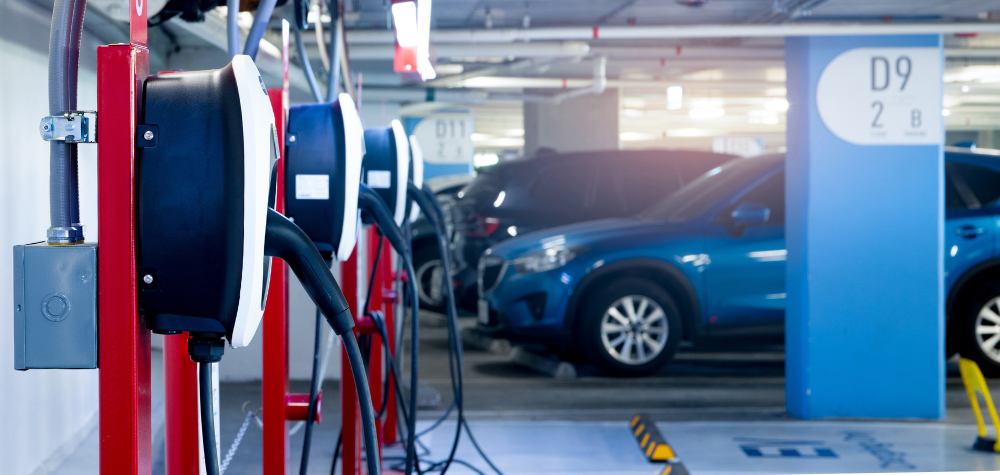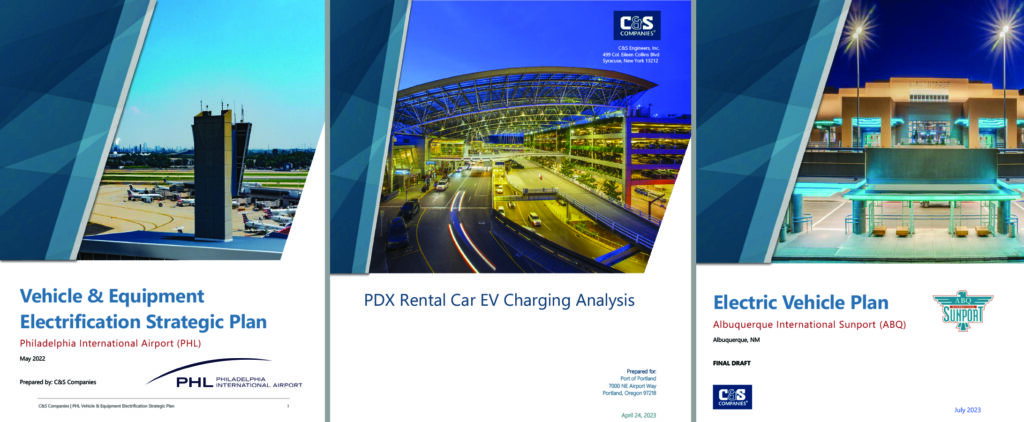Smoothly Navigate the Airport Electrification Transition with Our Supportive Solutions
By: Mia Held and Matt LaRue

The transportation sector is the primary source of greenhouse gas emissions (GHG) in the U.S (19%); of this, 81 percent is from cars and trucks.[1] As airports work towards understanding their own emissions and carbon footprint, adopting electric vehicles (EVs) has arisen as the key strategy for combatting GHG emissions in the transportation sector. Although the replacement of your existing fleet with electric vehicles can look straightforward on paper, it can be a rocky road. Don’t let the transition to electrification be a shock to your airport system! The C&S team has already supported airports across the country in planning for electrification. Whether you’re thinking about EVs and charging or have advanced to more complex scenarios such as the integration of EV charging with solar power generation and battery storage, C&S is ready to support your airport in making EVs part of a bigger picture of full airport electrification. Our team can help you whether the EV transition with scenario planning, site selection, electrical system evaluation, funding, and more.
UNDERSTANDING THE ELECTRIC VEHICLES LANDSCAPE
Across the airport industry, electrification of airside and landside vehicles and installation of EV and EV-ready charging infrastructure is expected to expand soon. This move is in line with the aviation industry’s transition to an increasingly decarbonized economy. Our C&S Sustainability Team continues to guide our airport clients though this phase via personalized studies and engineering evaluations to inform their electrification efforts. The team recently completed a robust Vehicle and Equipment Electrification Strategy at the Philadelphia Department of Aviation to guide its airports in the strategic transition from internal combustion engine vehicles to fully electric on both landside and airside. The study included a summary of local trends, a review of airport and tenant electrification goals and charging opportunities, and a series of interviews conducted with airport personnel and key stakeholders to make recommendations and set goals to help airports PHL and PNE lead the industry in electrification planning and strategy.

Similarly, C&S had produced guidance for electrification goals at San Antonio International Airport (SAT), Albuquerque International Sunport (ABQ), Portland International Airport (PDX), and are currently assessing the feasibility of multimodal airport charging stations in Michigan for the Michigan Department of Transportation. At Gerald R. Ford International Airport (GRR), C&S Companies was instrumental in securing funding for the airport to install solar and batteries on their maintenance facility to charge their maintenance vehicles at night. Whether your airport is interested in learning more about EVs or is well on your way to electrification, our team can put you ahead of the curve.
MAINTENANCE & ELECTRIC VEHICLES LIFECYCLE
The transition to EVs will have its advantages including lower lifetime maintenance costs. EVs generally have fewer required maintenance processes due to the removal of the most complicated pieces of gas-powered equivalents: the internal combustion engine (ICE) and transmission, resulting in lower maintenance costs. However, repair and diagnostic costs are higher for EVs as EV vehicle issues take additional time and expertise to repair. As more repair shops become accustomed to EV diagnostics for repairs and staff are trained to handle repair issues, repair costs can be expected to trend down over time. For government entities, there will be long-term cost savings in committing to training and certifying EV mechanics to address EV fleet repair and maintenance. On average, an EV can be expected to last 100,000 miles and at least eight years on its original battery. The recently passed Bipartisan Infrastructure Law (BIL), also known as Public Law 117-58 The Infrastructure Investment and Jobs Act, will include research on the cradle-to-grave lifecycle of EV batteries and other electric vehicle components.
ELECTRIFICATION OF THE AIRPORT VEHICLE ECOSYSTEM
Airports are increasingly focused on the electrification of their airport fleets and a phased transition from ICEs to EVs with EV adoption playing out at airports in both the landside and airside environments. The opportunities for vehicle electrification at airports are numerous and may include:
Common landside and airside vehicle-types at airports
| Landside Vehicles & Equipment | Airside Vehicles & Equipment |
| Parking and hotel shuttles | Airport & Tenant light/medium/and heavy-duty vehicles |
| Transportation Network Company Vehicles (TNCs) (including Uber and Lyft) | Aircraft Rescue and Firefighting Equipment (ARFF) |
| Ground Access Vehicles (GAV) including airport-passenger vehicles, employee vehicles, rental cars, taxis, etc. | Tenant Ground Support Equipment (GSE) (including baggage tugs, belt loaders, and pushbacks) |
| Delivery Vehicles | Airport GSE (Snow Removal Equipment (SREs)) |
| Local and Regional Transit Buses | Airside Shuttles |
| Law Enforcement / Security | Law Enforcement / Security |
Rental Car companies like Hertz are ‘leading the charge’ in an excited transition to electrification of rental car fleets, often without fully engaging with airports to understand how a phased approach to electrification might be smoother. The C&S Companies team recently completed a rental car electrification study at Portland International Airport in Portland, Oregon. This study included evaluating installation of DC fast charging within the quick turnaround facility where cars are typically washed and fueled, as well as Level 2 charging in the rental car parking garages where cars wait to be picked up by travelers. When evaluating the electrical distribution system for an installation of this magnitude, all aspects were investigated including:
- The limitations of existing infrastructure;
- How to integrate monitoring of usage into existing operations;
- Scenario planning for EV adoption that is in alignment with local and national EV trends as well as client-focused sustainability and resilience goals;
- Evaluation of appropriate application of electrical demand factors with respect to local code authority (i.e. at a certain number of chargers, is there a demand factor to reduce calculated load on the electrical distribution system);
- Consideration for the safety aspects of a high concentration of lithium-ion batteries in one place, and more.
Parking, and Software, and (Billing)….oh my!
How hands-on do you want to be with electrification? In the case of public-facing charging stations where payment will be collected, a number of different payment and ownership models are available to airports. The airport can choose to own, maintain, service, and operate the charging station, simply lease land for the charging infrastructure, or anything in-between.
Electrification funding is omnipresent—are you leaving dollars on the table?
Federal government support for increased vehicle electrification has been laid out in the Department of Transportation’s (DOT) Climate Action Plan for Resilience and the Federal Aviation Administration’s (FAA) Aviation Climate Action Plan. Two additional FAA programs, the Voluntary Airport Low Emissions Program (VALE) and Airport Zero Emissions Vehicle (ZEV) program, set the stage for the increased electrification of the aviation industry. Additional government investment is now set to rapidly increase the broader adoption of EVs nationwide. With the current presidential administration’s commitments to sustainability, climate adaptation, and resilience, it is the ideal time to understand your airport’s opportunities for EV transition to maximize funding eligibility and opportunities to help meet city, airport, and tenant commitments on electrification. The signing of the BIL in 2021 has led to a number of funding streams intended to increase electrification across the U.S. These programs include (but are not limited to):
- The $5 billion National Electric Vehicle Infrastructure (NEVI) Program which provides funding to U.S. states to buildout a national network of EV charging infrastructure along designated Alternative Fuel Corridors (AFCs).
- The Carbon Reduction Program (CRP) intended to increase strategies for carbon reduction. Our work on an Electric Vehicle Plan at the City of Albuquerque Aviation Department has already yielded a successful CRP grant application to fund publicly accessible EV chargers at the Albuquerque International Sunport (ABQ).
- The Charging and Fueling Infrastructure Discretionary Grant Program (CFI) supports the goals of the NEVI program in building out a network of EV charging and other alternative fueling infrastructure. The CFI program also has a special emphasis on buildout of both urban and rural areas with funding available for both community charging and corridor charging projects.
The C&S team can support you via an interdisciplinary team of planners and engineers with experience in all scopes and scales of electrification projects.

Matt LaRue, PE
Electrical Engineer, Facilities
